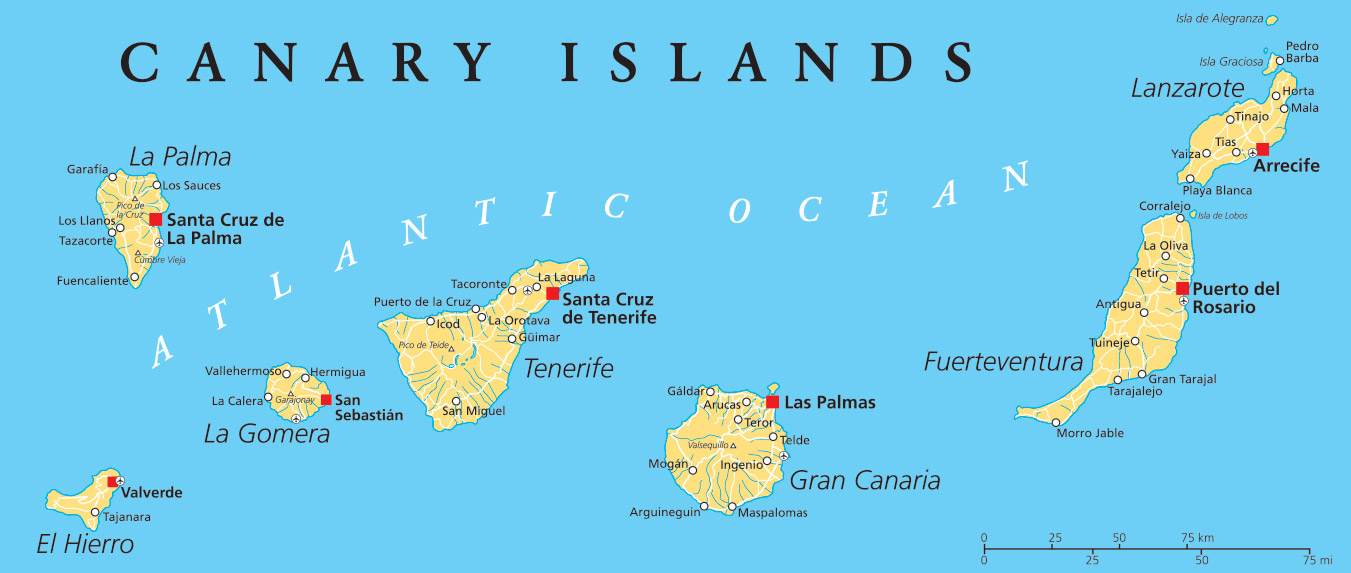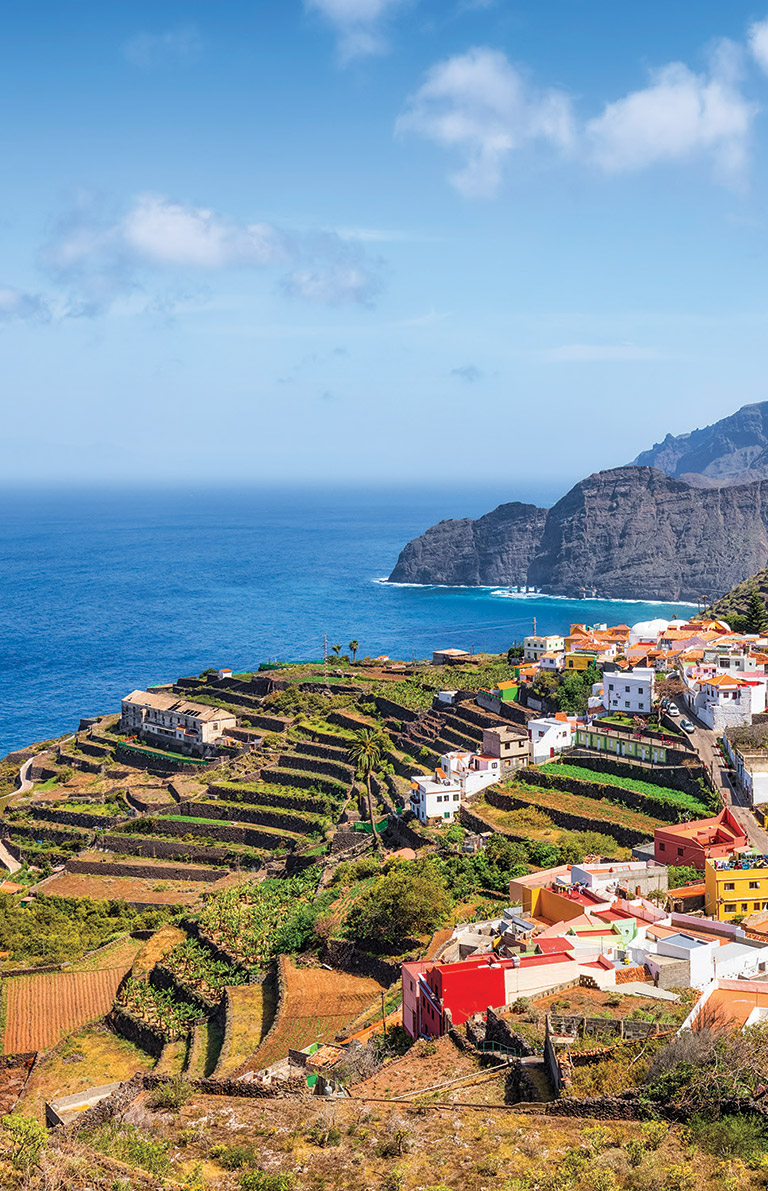WHERE THE CANARIES SING

Sunset watching is a popular attraction at Mount Teide on Tenerife.
Visit the diverse and dramatic islands
With sun-drenched beaches, lush forests, verdant grasslands, eclectic resort towns and year-round summer sun, Spain’s Canary Islands are a trendy holiday haven. When looking for a different experience, they offer an additional attraction that sets them apart from many other tourist destinations.
Millennia of volcanic eruptions on the floor of the Atlantic Ocean gave rise to this archipelago off the coast of North Africa, endowing it with a unique landscape.
That was the most intriguing element for Eastern Ontario resident Linda Wilcox during an island holiday, in December of 2015, with her husband and son. “The volcanic landscape is fascinating,” she says.
“It’s like a Martian landscape – just amazing. We had a lot of fun walking around and posing for pictures with the formations. It was really a unique experience.”
The family spent most of their time on Tenerife, the largest of the eight islands, dominated by Teide, Spain’s highest mountain and the world’s third highest volcano. Asked to recall an outstanding memory from the trip, Wilcox doesn’t hesitate to reference this landmark.

The eight-island archipelago sits in the Atlantic Ocean northwest of Africa directly adjacent to Morroco.
Millennia of volcanic eruptions on the floor of the Atlantic Ocean gave rise to this archipelago off the coast of North Africa.

The scenic town of Puerto de Mogan on Gran Canaria is known for its charming cottages, sporting wrought iron balconies and flower-festooned lanes.
“That’s easy!” she says. “We went on a sunset tour to Mount Teide. We wanted to get to the top of the mountain to see the sunset. We did, and it was awesome.”
The lunar-like landscape is a feature of all the islands. Lanzarote is called the ‘land of volcanoes’ with more than 100 shaping its almost moon-like ter-rain. In fact, astronauts and scientists from the European Space Agency have chosen this island as a training field for future missions. On the island of La Palma, the mountain peaks of Caldera de Taburiente National Park host an astronomic observatory.

Agulo is an enchanting town on the north coast of La Gomera, with cobbled stones and restored storybook-like houses.
Sun worshippers find much to entice them, since the islands are also renowned for their beaches. Soft sand ranges from sparkling white to golden and shiny black, formed from finely powdered lava rock. Because of its colour, the black sand absorbs heat and creates a warmer environment. Border-ing the shorelines are clear deep waters ideal for a variety of water sports.
Fuerteventura, the oldest of the islands that began to surface some 22 million years ago, boasts more than 150 beaches spread over 340 kilometres of coastline along the north and south shores. On the east coast, cliffs and small hidden coves – with myriad crev-ices, caves, tunnels, overhangs and rock formations – attract diving enthusiasts. Gran Canaria features a host of water sport possibilities.
It’s considered one of the best places in the world for wind-surfing and often hosts international competitions. Clear deep waters close to the coast on El Hierro are ideal for SCUBA diving and snorkeling. The island offers diving centres with schools for beginners and experts alike, as well as outings to the best local dive sites.

An aerial view of Tenerife’s beachside city of Puerto de la Cruz shows the volcano, Teide, Spain’s highest mountain, in the background.

La Palma’s high mountains make it ideal as a reference point in astrophysics with sites like the Roque de los Muchachos observatory, with its world-class telescopes.

Lanzarote’s Jardín de Cactus features more than 1,100 species of cacti.

El Hierro boasts almost 100 kilometres of rugged, cliff-lined coastline with coves, lagoons and rock formations. This arch at Charco Manso, near the northern village of Echedo is one example.

The island of Fuerteventura is renowned for beaches. This one is on the south-coast village of Morro Jable.
The lunar-like landscape is a feature of all the islands. Lanzarote is called the ‘land of volcanoes’ with more than 100 shaping its almost moon-like terrain.
A rugged coastline on La Gomera is the second smallest of the islands, measuring barely 20 kilometres from north to south. It is dotted with small black-sand beaches sprinkled between towering cliffs.
The newest Canary Island is also noted for its beaches of fine white or golden sand, bordered by calm sheltered coves and open waters, where larger waves require caution. Formerly an islet a kilometre off the northern tip of Lanzarote, La Graciosa attained official island status in 2018.
It’s the smallest of the islands at 29 square kilometres and is home to just over 700 residents in two settlements. It’s also largely undeveloped with no paved roads and protected lands that provide a habitat for numerous marine birds.
Its Chinijo Archipelago Natural Park is the largest marine reserve in Europe. The islands have been recognized by UNESCO’s World Network of Biosphere Reserves program, fostering the integration of people and nature for sustainable development, with numerous designated sites.
So, there’s no shortage of natural areas to explore. La Palma is the greenest island in the archipelago and a finalist in the European Commission’s EDEN (European Destinations of Excellence) program, recognizing sustainable tourism.
La Gomera is a land of contrasts with huge canyons and a mountainous landscape juxtaposed with palm-covered valleys and fertile forests. Its Garajonay National Park is a prehistoric forest with the UNESCO World Heritage designation.
In all, these tropical islands offer something for all vacation seekers. Linda Wilcox says she can highly recommend them and would welcome a return visit herself, to explore those she didn’t experience on her first Canaries excursion.
